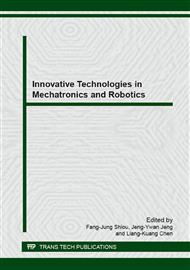[1]
A. Manz, N. Graber, and H. M. Widmer, Miniaturized Total Chemical Analysis Systems. A Novel Concept for Chemical Sensing. Sensors and Actuators, B: Chemical, B1, (1990) 244-248.
DOI: 10.1016/0925-4005(90)80209-i
Google Scholar
[2]
C. Zhang, D. Xing, and Y. Li, Micropumps, Microvalves, and Micromixers within Pcr Microfluidic Chips: Advances and Trends. Biotechnology Advances, 25, (2007) 483-514.
DOI: 10.1016/j.biotechadv.2007.05.003
Google Scholar
[3]
H. Becker and C. Gartner, Polymer Microfabrication Technologies for Microfluidic Systems. Analytical and Bioanalytical Chemistry, 390, (2008) 89-111.
DOI: 10.1007/s00216-007-1692-2
Google Scholar
[4]
A. Waldbaur, H. Rapp, K. Lange, and B. E. Rapp, Let There Be Chip - Towards Rapid Prototyping of Microfluidic Devices: One-Step Manufacturing Processes. Analytical Methods, 3, (2011) 2681-2716.
DOI: 10.1039/c1ay05253e
Google Scholar
[5]
A. Alrifaiy, O. A. Lindahl, and K. Ramser, Polymer-Based Microfluidic Devices for Pharmacy, Biology and Tissue Engineering. Polymers, 4, (2012) 1349-1398.
DOI: 10.3390/polym4031349
Google Scholar
[6]
M. K. S. Verma, A. Majumder, and A. Ghatak, Embedded Template-Assisted Fabrication of Complex Microchannels in Pdms and Design of a Microfluidic Adhesive. Langmuir, 22, (2006) 10291-10295.
DOI: 10.1021/la062516n
Google Scholar
[7]
A. D. Stroock, S. K. W. Dertinger, A. Ajdari, I. Mezić, H. A. Stone, and G. M. Whitesides, Chaotic Mixer for Microchannels. Science, 295, (2002) 647-651.
DOI: 10.1126/science.1066238
Google Scholar
[8]
A. P. Sudarsan and V. M. Ugaz, Fluid Mixing in Planar Spiral Microchannels. Lab on a Chip, 6, (2006) 74-82.
DOI: 10.1039/b511524h
Google Scholar
[9]
Y. W. Kim and J. Y. Yoo, Three-Dimensional Focusing of Red Blood Cells in Microchannel Flows for Bio-Sensing Applications. Biosensors and Bioelectronics, 24, (2009) 3677-3682.
DOI: 10.1016/j.bios.2009.05.037
Google Scholar
[10]
R. H. Liu, M. A. Stremler, K. V. Sharp, M. G. Olsen, J. G. Santiago, R. J. Adrian, H. Aref, and D. J. Beebe, Passive Mixing in a Three-Dimensional Serpentine Microchannel. Microelectromechanical Systems, Journal of, 9, (2000) 190-197.
DOI: 10.1109/84.846699
Google Scholar
[11]
M. N. De Silva, J. Paulsen, M. J. Renn, and D. J. Odde, Two-Step Cell Patterning on Planar and Complex Curved Surfaces by Precision Spraying of Polymers. Biotechnology and Bioengineering, 93, (2006) 919-927.
DOI: 10.1002/bit.20787
Google Scholar
[12]
A. Folch and M. Toner, Cellular Micropatterns on Biocompatible Materials. Biotechnology Progress, 14, (1998) 388-392.
DOI: 10.1021/bp980037b
Google Scholar
[13]
D. T. Chiu, N. L. Jeon, S. Huang, R. S. Kane, C. J. Wargo, I. S. Choi, D. E. Ingber, and G. M. Whitesides, Patterned Deposition of Cells and Proteins onto Surfaces by Using Three-Dimensional Microfluidic Systems. Proceedings of the National Academy of Sciences, 97, (2000).
DOI: 10.1073/pnas.040562297
Google Scholar
[14]
N. -T. Nguyen and Z. Wu, Micromixers - a Review. Journal of Micromechanics and Microengineering, 15, (2005) R1-R16.
DOI: 10.1088/0960-1317/15/2/r01
Google Scholar
[15]
V. Hessel, H. Löwe, and F. Schönfeld, Micromixers—a Review on Passive and Active Mixing Principles. Chemical Engineering Science, 60, (2005) 2479-2501.
DOI: 10.1016/j.ces.2004.11.033
Google Scholar
[16]
A. W. Browne, M. J. Rust, W. Jung, S. H. Lee, and C. H. Ahn, A Rapid Prototyping Method for Polymer Microfluidics with Fixed Aspect Ratio and 3d Tapered Channels. Lab Chip, 9, (2009) 2941-2946.
DOI: 10.1039/b903755a
Google Scholar
[17]
M. Vaezi, H. Seitz, and S. Yang, A Review on 3d Micro-Additive Manufacturing Technologies. International Journal of Advanced Manufacturing Technology, 67, (2013) 1721-1754.
DOI: 10.1007/s00170-012-4605-2
Google Scholar
[18]
The Dow Chemical Company. Epoxy Resins Product Overview [cited 2014 July 14]; Available from: http: /msdssearch. dow. com/PublishedLiteratureDOWCOM/dh_03ee/0901b803803ee43d. pdf?filepath=/296-01885. pdf&fromPage=GetDoc.
Google Scholar
[19]
A. J. T. Scarr, Metrology and Precision Engineering,London, New York McGraw-Hill,(1967).
Google Scholar
[20]
Y. Lin, G. J. Gerfen, D. L. Rousseau, and S. -R. Yeh, Ultrafast Microfluidic Mixer and Freeze-Quenching Device. Analytical Chemistry, 75, (2003) 5381-5386.
DOI: 10.1021/ac0346205
Google Scholar


